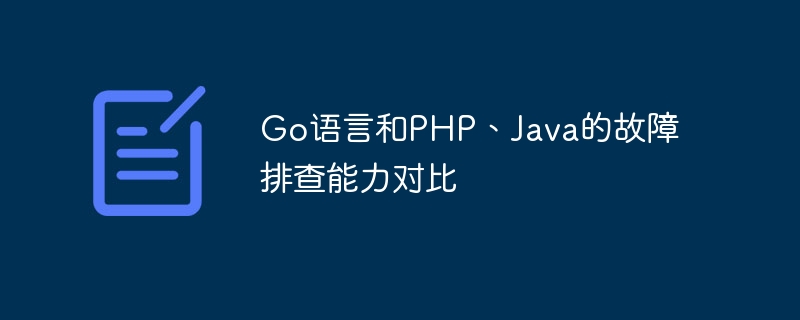Home >Backend Development >PHP Tutorial >Comparison of troubleshooting capabilities between Go language, PHP and Java
Comparison of troubleshooting capabilities between Go language, PHP and Java
- 王林Original
- 2023-09-08 12:27:24755browse

Comparison of troubleshooting capabilities between Go language, PHP and Java
With the rapid development of information technology, the scale and complexity of software systems continue to increase, and troubleshooting has become a Essential skills for development and operation and maintenance personnel. Different programming languages have certain differences in their troubleshooting capabilities. This article will compare the differences between Go language, PHP and Java in terms of troubleshooting capabilities, and illustrate them through code examples.
First of all, Go language has unique advantages in troubleshooting. It has strict type checking and static compilation features, which can detect some potential problems during compilation, such as unused variables, type mismatch, etc. This enables the Go language to avoid some common mistakes during the development phase and reduce the possibility of failures.
In addition, the Go language also has a built-in powerful error handling mechanism. By using multiple return values and error types, various possible errors can be handled concisely. This makes it easy to track and locate problems in the Go language code and improves the efficiency of troubleshooting.
The following is a simple example that demonstrates the error handling mechanism of the Go language:
func divide(a, b int) (int, error) {
if b == 0 {
return 0, errors.New("division by zero")
}
return a / b, nil
}
func main() {
result, err := divide(10, 0)
if err != nil {
log.Println(err)
return
}
fmt.Println(result)
}In comparison, PHP and Java are relatively difficult to troubleshoot. First of all, PHP is a weakly typed language, the types are not strict, and some implicit type conversion problems are prone to occur. This may cause some potential errors to be ignored in some cases, making troubleshooting more difficult.
Secondly, the error handling mechanisms of PHP and Java are relatively cumbersome. PHP uses an exception handling mechanism to handle errors, but you need to manually write try-catch statements to catch and handle exceptions. This requires developers to consider possible exceptions when writing code and handle them reasonably. Similarly, Java also uses a similar exception handling mechanism, but it requires writing a large number of try-catch statements, making the code lengthy and difficult to read.
The following is an example using PHP, demonstrating the exception handling mechanism:
function divide($a, $b) {
if ($b == 0) {
throw new Exception("division by zero");
}
return $a / $b;
}
try {
$result = divide(10, 0);
echo $result;
} catch (Exception $e) {
echo $e->getMessage();
}To sum up, the Go language has higher efficiency and higher troubleshooting capabilities than PHP and Java. Convenience. Its strict type checking and static compilation features and built-in error handling mechanism make it easier for developers to find and troubleshoot problems when writing and debugging code. PHP and Java are relatively cumbersome in this regard, requiring more manpower and time to troubleshoot. Therefore, when choosing a programming language, developers can consider using the Go language to improve troubleshooting efficiency.
(Note: The above sample code is only a simple example, and more complex error handling mechanisms may be required in actual applications.)
Reference:
- Go language Official documentation: https://golang.org/
- PHP official documentation: https://www.php.net/
- Java official documentation: https://docs.oracle.com /
The above is the detailed content of Comparison of troubleshooting capabilities between Go language, PHP and Java. For more information, please follow other related articles on the PHP Chinese website!

